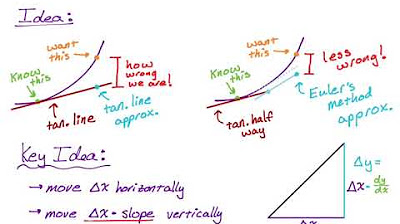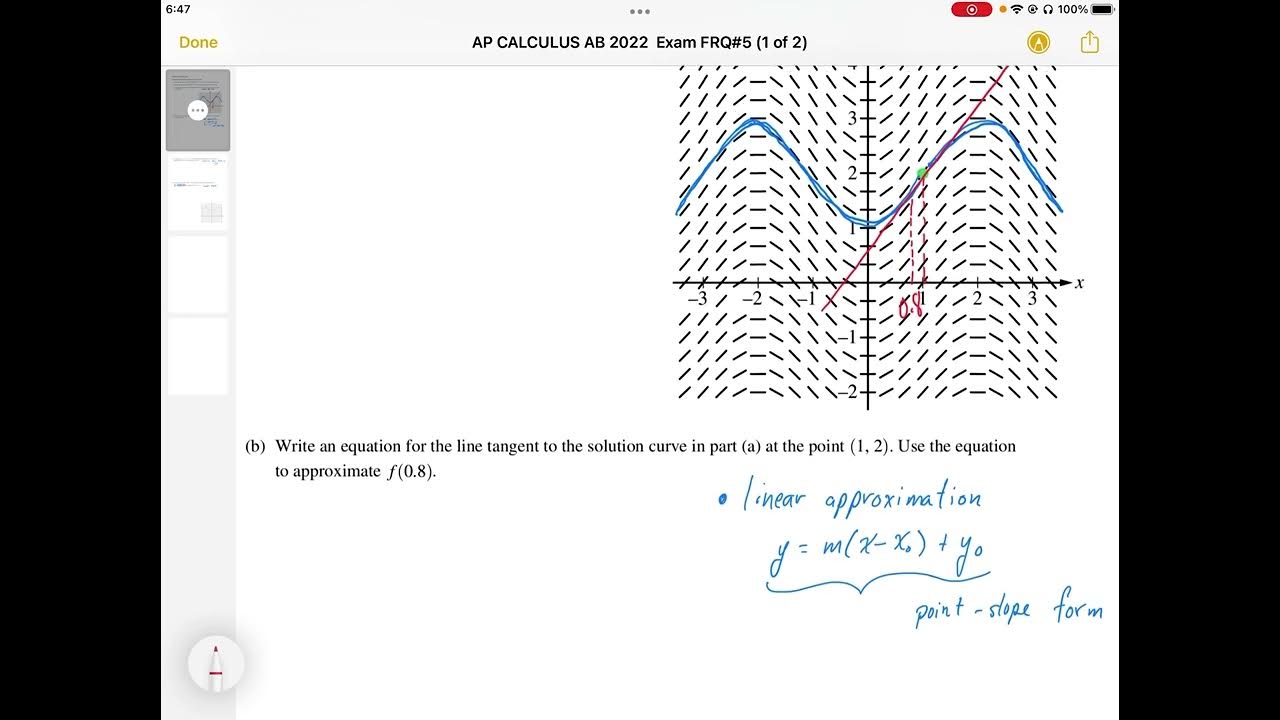Math
TLDRThe video script presents a method to estimate the value of 2.99 raised to the fourth power without a calculator by using principles of calculus. It involves replacing 2.99 with a variable, choosing an integer value close to it, and finding the tangent line's slope at that point. By calculating the derivative and applying the point-slope formula, the script guides through deriving a linear equation that approximates the function's behavior near the chosen integer. The estimated value is rounded to the nearest tenth, and the accuracy is confirmed with a calculator, demonstrating an acceptable approximation.
Takeaways
- 📝 The problem involves estimating the value of 2.99 raised to the fourth power without a calculator.
- 🔍 A variable x is introduced to replace 2.99, transforming the problem into finding the value of x^4.
- 🏹 An integer close to 2.99 is chosen for simplification, in this case, the integer 3.
- 📌 The behavior of the function f(x) = x^4 near x=2.99 is approximated using a linear equation.
- 🔢 The y-value for the chosen x=3 is calculated as 3^4, which equals 81.
- 🚦 The slope of the tangent line at x=3 is found by taking the derivative of f(x) = x^4, resulting in f'(x) = 4x^3.
- 📈 The slope at x=3 is calculated as 4 * 3^3, which equals 108.
- 📑 The point-slope form of the linear equation is used to approximate the curve: y - y1 = m(x - x1).
- 🔧 The equation is then used to estimate the value of 2.99^4 by plugging in x=2.99: y = 108(2.99) - 3 + 81.
- 🧮 The estimated result without a calculator is 79.9, which is close to the actual value obtained using a calculator (79.9253...).
- 📈 This method is effective for estimating values near integer points and simplifies the process when dealing with numbers close to 3, 4, or 5.
Q & A
What is the main topic of the video?
-The main topic of the video is about estimating the value of 2.99 raised to the fourth power, rounded to the nearest tenth place, without using a calculator.
How does the video propose to estimate the value without a calculator?
-The video proposes to estimate the value by using a method that involves calculus to create a linear equation that approximates the behavior of the function near the value of interest.
What is the role of calculus in this estimation process?
-Calculus is used to find the derivative of the function, which helps determine the slope of the tangent line at the point of interest, and thus allows for the creation of a linear approximation of the function.
What is the function f(x) that is used in the video?
-The function f(x) used in the video is x to the fourth power, represented as f(x) = x^4.
How is the integer value close to 2.99 chosen for the estimation?
-The integer value close to 2.99 is chosen by rounding up to the nearest whole number, which in this case is 3.
What is the y-value calculated for the chosen x-value of 3?
-The y-value calculated for the x-value of 3 is 81, which is the result of 3 raised to the fourth power (3^4).
How is the slope of the tangent line determined?
-The slope of the tangent line is determined by finding the first derivative of the function f(x), and then evaluating this derivative at the chosen x-value. In this case, the derivative is 4 times x to the third power, and at x = 3, it results in a slope of 108.
What is the linear equation derived in the video?
-The linear equation derived in the video is y = 108(x - 3) + 81, which approximates the behavior of the function f(x) = x^4 near x = 3.
How is the estimated value of 2.99^4 calculated using the linear equation?
-The estimated value is calculated by plugging x = 2.99 into the linear equation. This results in y = 108(2.99 - 3) + 81, which simplifies to y = 108 * -0.01 + 81, and further to y = -1.08 + 81, resulting in an estimated value of 79.92 before rounding to 79.9.
How does the video confirm the accuracy of the estimation?
-The video confirms the accuracy of the estimation by using a calculator to find the exact value of 2.99^4 and comparing it to the estimated value. The calculated value is 79.92538801, which rounds to 79.9, matching the estimated value.
What is the significance of choosing integer values close to the number of interest?
-Choosing integer values close to the number of interest simplifies the mathematical process. It makes the calculation of the derivative and the creation of the linear approximation easier, especially when dealing with numbers like 3, 4, or 5.
Outlines
🧠 Estimating Powers of Numbers Without a Calculator
This paragraph introduces a method for estimating the value of 2.99 raised to the fourth power without using a calculator. It explains the process of replacing the number with a variable, choosing an integer value close to it (in this case, 3), and then using calculus to find a linear approximation near the chosen value. The steps involve finding the x and y coordinates of a point on the curve, calculating the slope of the tangent line at that point, and using the point-slope formula to create a linear equation that approximates the function f(x) = x^4. The paragraph also demonstrates how to apply this linear equation to estimate the value when x is 2.99, leading to an approximate result of 79.9.
🔢 Confirming the Estimation with a Calculator
This paragraph continues the discussion from the previous one by confirming the estimated value using a calculator. It shows the process of calculating 2.99 to the fourth power exactly, resulting in 79.92538801. The paragraph highlights that the estimated value of 79.9 is very close to the exact value, demonstrating the effectiveness of the approximation method. It emphasizes that this technique is particularly useful for numbers close to integer values, simplifying the mathematical process and providing reasonably accurate results.
Mindmap
Keywords
💡Estimate
💡Calculator
💡Variable
💡Function
💡Linear Equation
💡Derivative
💡Tangent Line
💡Point-Slope Formula
💡Approximation
💡Integer
💡Calculus
💡Rounding
Highlights
Estimating 2.99 to the fourth power without a calculator using calculus.
Replacing 2.99 with a variable x to simplify the problem.
Choosing an integer value close to 2.99, which is 3.
Writing a linear equation to describe the function's behavior near the chosen value.
Determining the y value by calculating 3 to the fourth power.
Calculating the slope of the tangent line using the first derivative.
Derivative of x to the n power is n times x to the n minus 1.
Calculating the derivative of x to the fourth power, f prime of x.
Using the point-slope formula to write the linear equation.
Estimating the y value when x is 2.99 with the linear equation.
Rounding the estimated value to the nearest tenth place.
Confirming the estimated value with a calculator for accuracy.
The method's applicability for numbers close to integer values.
The simplicity of math when numbers are close to numbers like 3, 4, or 5.
The process of moving the decimal point to adjust the value.
Breaking down the calculation into simpler steps for clarity.
The final estimated value is approximately 79.9.
The exact value calculated by the calculator is 79.9253.
The method is acceptable for estimating values close to integer points.
Transcripts
Browse More Related Video

Estimating Function Values Using Differentials and Local Linearization | Calculus

Equation of a tangent line [IB Maths AI SL/HL]

Euler's Method for Approximating Values of a Function

2010 AP Calculus AB Free Response #6

Euler's method | Differential equations| AP Calculus BC | Khan Academy

AP CALCULUS AB 2022 Exam Full Solution FRQ#5(a,b)
5.0 / 5 (0 votes)
Thanks for rating: